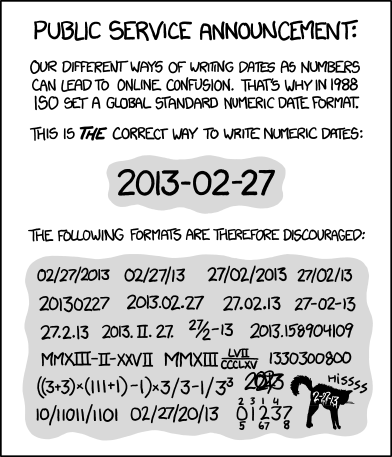
I think Sweden adopted ISO 8601 sometime around when it came. Before that we would write dates as day/month-year (that would be discouraged format number 11 on the image to the right).
Then came along Internet Information Server (IIS) invented by an American firm you might now, called Microsoft. In the US where Microsoft lives, dates are written using discouraged format number 1, or perhaps 2, unless it’s 3 or 4, I never manage to keep track.
Most of the time it’s possible to just ignore the highly illogical way of mixing up days and months and years in the US way of writing things. ISO 8601 goes from larger to smaller, the old Swedish way went from smaller to larger, the US way goes from uh… large to smallest, to largest…
However, a project I was involved in a couple of months ago used some form of standard date widget in IIS (Internet Information Server, Microsoft’s Web Server) that used discouraged format number 1 above.
Now for the fun part. In my humble and naïve mind this should be a question of just setting a language setting somewhere in the web server to get it right. Apparently it wasn’t (!?) Instead everyone was running with the totally confusing US-dates. The budget did not have room for making the change, and it seemed everyone humbly adopted… after all, there was a “date browser” that could be opened pressing a button (first time it took a minute to open, but then it was business as usual). I’m guessing they used that function to get their dates, or perhaps I’m just an old fossil that doesn’t adopt well.
So the punchline (unless the previous sentence wasn’t punchline enough for you…): yeah standard until some guy comes along and wants it otherwise, and this guy has all the power… then it’s a (quote-unquote) “standard” and not a standard any more.
